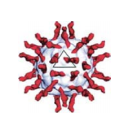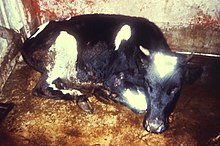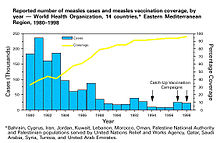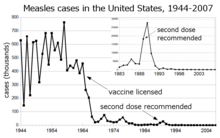| Poliovirus 1 | |
|---|---|

| |
| TEM micrograph of poliovirus virions. Scale bar, 50 nm. | |

| |
| A type 3 poliovirus capsid coloured by chains | |
| Virus classification | |
| (unranked): | Virus |
| Realm: | Riboviria |
| (unranked): | incertae sedis |
| Order: | Picornavirales |
| Family: | Picornaviridae |
| Genus: | Enterovirus |
| Species: | Enterovirus C |
| Virus: |
Poliovirus 1
|
Poliovirus, the causative agent of polio (also known as poliomyelitis), is a member virus of Enterovirus C, in the family of Picornaviridae.
Poliovirus is composed of an RNA genome and a protein capsid. The genome is a single-stranded positive-sense RNA genome that is about 7500 nucleotides long. The viral particle is about 30 nm in diameter with icosahedral symmetry. Because of its short genome and its simple composition—only RNA and a nonenveloped icosahedral protein coat that encapsulates it, poliovirus is widely regarded as the simplest significant virus.
Poliovirus was first isolated in 1909 by Karl Landsteiner and Erwin Popper. In 1981, the poliovirus genome was published by two different teams of researchers: by Vincent Racaniello and David Baltimore at MIT and by Naomi Kitamura and Eckard Wimmer at Stony Brook University. Poliovirus is one of the most well-characterized viruses, and has become a useful model system for understanding the biology of RNA viruses.
Replication cycle
The
replication cycle of poliovirus is initiated (1) by binding to the cell
surface receptor CD155. The virion is taken up via endocytosis, and the
viral RNA is released (2). Translation of the viral RNA occurs by an
IRES-mediated mechanism (3). The polyprotein is cleaved, yielding mature
viral proteins (4). The positive-sense RNA serves as template for
complementary negative-strand synthesis, producing double-stranded
replicative form (RF) RNA(5). Many positive strand RNA copies are
produced from the single negative strand (6). The newly synthesized
positive-sense RNA molecules can serve as templates for translation of
more viral proteins (7) or can be enclosed in a capsid (8), which
ultimately generates progeny virions. Lysis of the infected cell results
in release of infectious progeny virions (9).
Poliovirus infects human cells by binding to an immunoglobulin-like receptor, CD155 (also known as the poliovirus receptor or PVR) on the cell surface.
Interaction of poliovirus and CD155 facilitates an irreversible
conformational change of the viral particle necessary for viral entry. Attached to the host cell membrane, entry of the viral nucleic acid was thought to occur one of two ways: via the formation of a pore in the plasma membrane through which the RNA is then “injected” into the host cell cytoplasm, or that the virus is taken up by receptor-mediated endocytosis.
Recent experimental evidence supports the latter hypothesis and
suggests that poliovirus binds to CD155 and is taken up by endocytosis.
Immediately after internalization of the particle, the viral RNA is
released.
Poliovirus is a positive-stranded RNA virus. Thus, the genome enclosed within the viral particle can be used as messenger RNA and immediately translated
by the host cell. On entry, the virus hijacks the cell's translation
machinery, causing inhibition of cellular protein synthesis in favor of
virus-specific protein production. Unlike the host cell's mRNAs, the 5' end of poliovirus RNA is extremely long—over 700 nucleotides—and highly structured. This region of the viral genome is called internal ribosome entry site (IRES), and it directs translation of the viral RNA. Genetic mutations in this region prevent viral protein production. The first IRES to be discovered was found in poliovirus RNA.
Poliovirus mRNA is translated as one long polypeptide.
This polypeptide is then autocleaved by internal proteases into about
10 individual viral proteins. Not all cleavages occur with the same
efficiency. Therefore, the amounts of proteins produced by the
polypeptide cleavage vary: for example, smaller amounts of 3Dpol are produced than those of capsid proteins, VP1–4. These individual viral proteins are:
The genomic structure of poliovirus type 1
- 3Dpol, an RNA dependent RNA polymerase whose function is to make multiple copies of the viral RNA genome
- 2Apro and 3Cpro/3CDpro, proteases which cleave the viral polypeptide
- VPg (3B), a small protein that binds viral RNA and is necessary for synthesis of viral positive and negative strand RNA
- 2BC, 2B, 2C (an ATPase)[23], 3AB, 3A, 3B proteins which comprise the protein complex needed for virus replication.
- VP0, which is further cleaved into VP2 and VP4, VP1 and VP3, proteins of the viral capsid
After translation, transcription and genome replication which involve
a single process (synthesis of (+) RNA) is realized. For the infecting
(+) RNA to be replicated, multiple copies of (−) RNA must be transcribed
and then used as templates for (+) RNA synthesis. Replicative
intermediates (RIs) which are an association of RNA molecules consisting
of a template RNA and several growing RNAs of varying length, are seen
in both the replication complexes for (−) RNAs and (+) RNAs. The primer
for both (+) and (−) strand synthesis is the small protein VPg, which is
uridylylated at the hydroxyl group of a tyrosine residue by the
poliovirus RNA polymerase at a cis-acting replication element located
in a stem-loop in the virus genome. Some of the (+) RNA molecules are
used as templates for further (−) RNA synthesis, some function as mRNA,
and some are destined to be the genomes of progeny virions.
In the assembly of new virus particles (i.e. the packaging of
progeny genome into a procapsid which can survive outside the host
cell), including, respectively:
- Five copies each of VP0, VP3, and VP1 which its N termini and VP4 form interior surface of capsid, assemble into a ‘pentamer’ and 12 pentamers form a procapsid. (The outer surface of capsid is consisting of VP1, VP2, VP3; C termini of VP1 and VP3 form the canyons which around each of the vertices; around this time, the 60 copies of VP0 are cleaved into VP4 and VP2.)
- Each procapsid acquires a copy of the virus genome, with VPg still attached at the 5' end.
Fully assembled poliovirus leaves the confines of its host cell by lysis 4 to 6 hours following initiation of infection in cultured mammalian cells. The mechanism of viral release from the cell is unclear, but each dying cell can release up to 10,000 polio virions.
Drake demonstrated that poliovirus is able to undergo multiplicity reactivation.
That is, when polioviruses were irradiated with UV light and allowed
to undergo multiple infections of host cells, viable progeny could be
formed even at UV doses that inactivated the virus in single infections.
Origin and serotypes
Poliovirus is structurally similar to other human enteroviruses (coxsackieviruses, echoviruses, and rhinoviruses), which also use immunoglobulin-like molecules to recognize and enter host cells. Phylogenetic analysis of the RNA and protein sequences of poliovirus suggests that it may have evolved from a C-cluster Coxsackie A virus ancestor, that arose through a mutation within the capsid. The distinct speciation of poliovirus probably occurred as a result of change in cellular receptor specificity from intercellular adhesion molecule-1 (ICAM-1), used by C-cluster Coxsackie A viruses, to CD155; leading to a change in pathogenicity, and allowing the virus to infect nervous tissue.
The mutation rate in the virus is relatively high even for an RNA virus with a synonymous substitution rate of 1.0 x 10−2 substitutions/site/year and
non synonymous substitution rate of 3.0 x 10−4 substitutions/site/year. Base distribution within the genome is not random with adenosine being less common than expected at the 5' end and higher at the 3' end. Codon use is not random with codons ending in adenosine being favoured and those ending in cytosine or guanine being avoided. Codon use differs between the three genotypes and appears to be driven by mutation rather than selection.
The three serotypes of poliovirus, PV1, PV2, and PV3, each have a slightly different capsid protein. Capsid proteins define cellular receptor specificity and virus antigenicity. PV1 is the most common form encountered in nature, but all three forms are extremely infectious.
As of November 2015, wild PV1 is highly localized to regions in
Pakistan and Afghanistan. Wild PV2 was declared eradicated in September
2015 after last being detected in October 1999 in Uttar Pradesh, India. As of November 2015, wild PV3 has not been seen since its 2012 detection in parts of Nigeria and Pakistan.
Specific strains of each serotype are used to prepare vaccines against polio. Inactive polio vaccine is prepared by formalin
inactivation of three wild, virulent reference strains, Mahoney or
Brunenders (PV1), MEF-1/Lansing (PV2), and Saukett/Leon (PV3). Oral
polio vaccine contains live attenuated (weakened) strains of the three serotypes of poliovirus. Passaging
the virus strains in monkey kidney epithelial cells introduces
mutations in the viral IRES, and hinders (or attenuates) the ability of
the virus to infect nervous tissue.
Polioviruses were formerly classified as a distinct species belonging to the genus Enterovirus in the family Picornaviridae. In 2008, the Poliovirus species was eliminated and the three serotypes were assigned to the species Human enterovirus C (later renamed Enterovirus C), in the genus Enterovirus in the family Picornaviridae. The type species of the genus Enterovirus was changed from Poliovirus to (Human) Enterovirus C.
Pathogenesis
Electron micrograph of poliovirus
The primary determinant of infection for any virus is its ability to
enter a cell and produce additional infectious particles. The presence
of CD155 is thought to define the animals and tissues that can be
infected by poliovirus. CD155 is found (outside of laboratories) only on
the cells of humans, higher primates, and Old World monkeys. Poliovirus is, however, strictly a human pathogen, and does not naturally infect any other species (although chimpanzees and Old World monkeys can be experimentally infected).
The CD155 gene appears to have been subject to positive selection.
The protein has several domains of which domain D1 contains the polio
virus binding site. Within this domain, 37 amino acids are responsible
for binding the virus.
Poliovirus is an enterovirus. Infection occurs via the fecal–oral route, meaning that one ingests the virus and viral replication occurs in the alimentary tract. Virus is shed in the feces of infected individuals. In 95% of cases only a primary, transient presence of viremia (virus in the bloodstream) occurs, and the poliovirus infection is asymptomatic. In about 5% of cases, the virus spreads and replicates in other sites such as brown fat, reticuloendothelial tissue, and muscle.
The sustained viral replication causes secondary viremia and leads to
the development of minor symptoms such as fever, headache, and sore
throat. Paralytic poliomyelitis occurs in less than 1% of poliovirus infections. Paralytic disease occurs when the virus enters the central nervous system (CNS) and replicates in motor neurons within the spinal cord, brain stem, or motor cortex, resulting in the selective destruction of motor neurons leading to temporary or permanent paralysis. In rare cases, paralytic poliomyelitis leads to respiratory arrest
and death. In cases of paralytic disease, muscle pain and spasms are
frequently observed prior to onset of weakness and paralysis. Paralysis
typically persists from days to weeks prior to recovery.
In many respects, the neurological phase of infection is thought to be an accidental diversion of the normal gastrointestinal infection.
The mechanisms by which poliovirus enters the CNS are poorly
understood. Three nonmutually exclusive hypotheses have been suggested
to explain its entry. All theories require primary viremia. The first
hypothesis predicts that virions pass directly from the blood into the
central nervous system by crossing the blood–brain barrier independent of CD155.
A second hypothesis suggests that the virions are transported from
peripheral tissues that have been bathed in the viremic blood, for
example muscle tissue, to the spinal cord through nerve pathways via retrograde axonal transport. A third hypothesis is that the virus is imported into the CNS via infected monocytes or macrophages.
Poliomyelitis is a disease of the central nervous system.
However, CD155 is believed to be present on the surface of most or all
human cells. Therefore, receptor expression does not explain why
poliovirus preferentially infects certain tissues. This suggests that
tissue tropism is determined after cellular infection. Recent work has suggested that the type I interferon
response (specifically that of interferon alpha and beta) is an
important factor that defines which types of cells support poliovirus
replication.
In mice expressing CD155 (through genetic engineering) but lacking the
type I interferon receptor, poliovirus not only replicates in an
expanded repertoire of tissue types, but these mice are also able to be
infected orally with the virus.
Immune system avoidance
CD155 molecules complexed with a poliovirus particle. Reconstructed image from cryo-electron microscopy.
Poliovirus uses two key mechanisms to evade the immune system. First, it is capable of surviving the highly acidic conditions of the stomach, allowing the virus to infect the host and spread throughout the body via the lymphatic system. Second, because it can replicate very quickly, the virus overwhelms the host organs before an immune response can be mounted.
If detail is given at the attachment phase; poliovirus with canyons on
the virion surface have virus attachment sites located in pockets at the
canyon bases. The canyons are too narrow for access by antibodies, so
the virus attachment sites are protected from the host’s immune
surveillance, while the remainder of the virion surface can mutate to
avoid the host’s immune response.
Individuals who are exposed to poliovirus, either through infection or by immunization with polio vaccine, develop immunity. In immune individuals, antibodies against poliovirus are present in the tonsils and gastrointestinal tract (specifically IgA antibodies) and are able to block poliovirus replication; IgG and IgM antibodies against poliovirus can prevent the spread of the virus to motor neurons of the central nervous system. Infection with one serotype of poliovirus does not provide immunity against the other serotypes, however second attacks within the same individual are extremely rare .
PVR transgenic mouse
Although
humans are the only known natural hosts of poliovirus, monkeys can be
experimentally infected and they have long been used to study
poliovirus. In 1990–91, a small animal model of poliomyelitis was
developed by two laboratories. Mice were engineered to express a human receptor to poliovirus (hPVR).
Unlike normal mice, transgenic poliovirus receptor (TgPVR) mice are susceptible to poliovirus injected intravenously or intramuscularly, and when injected directly into the spinal cord or the brain.
Upon infection, TgPVR mice show signs of paralysis that resemble those
of poliomyelitis in humans and monkeys, and the central nervous systems
of paralyzed mice are histocytochemically
similar to those of humans and monkeys. This mouse model of human
poliovirus infection has proven to be an invaluable tool in
understanding poliovirus biology and pathogenicity.
Three distinct types of TgPVR mice have been well studied:
- In TgPVR1 mice, the transgene encoding the human PVR was incorporated into mouse chromosome 4. These mice express the highest levels of the transgene and the highest sensitivity to poliovirus. TgPVR1 mice are susceptible to poliovirus through the intraspinal, intracerebral, intramuscular, and intravenous pathways, but not through the oral route.
- TgPVR21 mice have incorporated the human PVR at chromosome 13. These mice are less susceptible to poliovirus infection through the intracerebral route, possibly because they express decreased levels of hPVR. TgPVR21 mice have been shown to be susceptible to poliovirus infection through intranasal inoculation, and may be useful as a mucosal infection model.
- In TgPVR5 mice, the human transgene is located on chromosome 12. These mice exhibit the lowest levels of hPVR expression and are the least susceptible to poliovirus infection.
Recently, a fourth TgPVR mouse model was developed. These "cPVR" mice carry hPVR cDNA, driven by a β-actin promoter,
and have proven susceptible to poliovirus through intracerebral,
intramuscular, and intranasal routes. In addition, these mice are
capable of developing the bulbar form of polio after intranasal inoculation.
The development of the TgPVR mouse has had a profound effect on oral poliovirus vaccine
(OPV) production. Previously, monitoring the safety of OPV had to be
performed using monkeys, because only primates are susceptible to the
virus. In 1999, the World Health Organization
approved the use of the TgPVR mouse as an alternative method of
assessing the effectiveness of the vaccine against poliovirus type-3. In
2000, the mouse model was approved for tests of vaccines against type-1
and type-2 poliovirus.
Cloning and synthesis
Model of poliovirus-binding CD155 (shown in purple)
In 1981, Racaniello and Baltimore used recombinant DNA technology to generate the first infectious clone
of an animal RNA virus, poliovirus. DNA encoding the RNA genome of
poliovirus was introduced into cultured mammalian cells and infectious
poliovirus was produced.
Creation of the infectious clone propelled understanding of poliovirus
biology, and has become a standard technology used to study many other
viruses.
In 2002, Eckard Wimmer's group at SUNY Stony Brook succeeded in synthesizing poliovirus from its chemical code, producing the world's first synthetic virus.
Scientists first converted poliovirus's published RNA sequence, 7741
bases long, into a DNA sequence, as DNA was easier to synthesize. Short
fragments of this DNA sequence were obtained by mail-order, and
assembled. The complete viral genome was then assembled by a gene synthesis company. This whole painstaking process took two years. Nineteen markers were incorporated into the synthesized DNA, so that it could be distinguished from natural poliovirus. Enzymes
were used to convert the DNA back into RNA, its natural state. Other
enzymes were then used to translate the RNA into a polypeptide,
producing functional viral particle. The newly minted synthetic virus
was injected into PVR transgenic mice, to determine if the synthetic
version was able to cause disease. The synthetic virus was able to
replicate, infect, and cause paralysis or death in mice. However, the
synthetic version was between 1/1,000th and 1/10,000th as lethal as the
original virus.
Modification for therapies
A modification of the poliovirus, called PVSRIPO, was tested in early clinical trials as a possible treatment for cancer.[58][needs update]




















